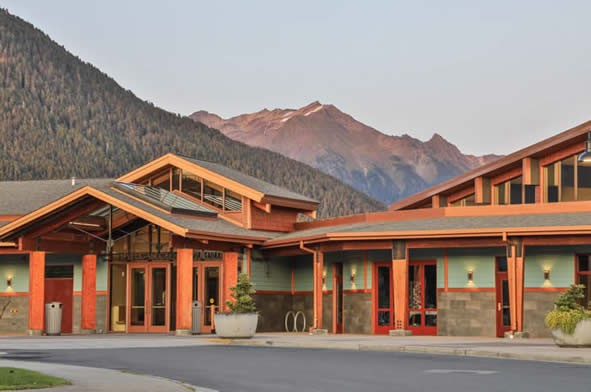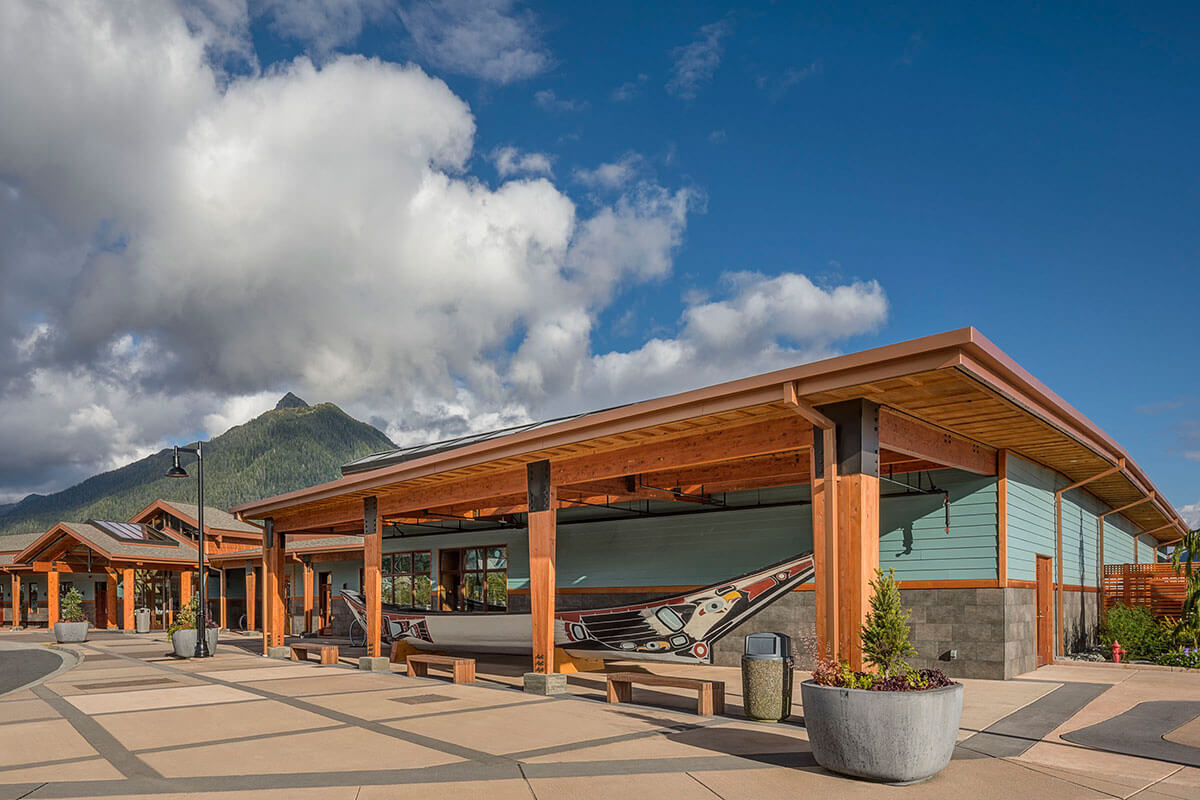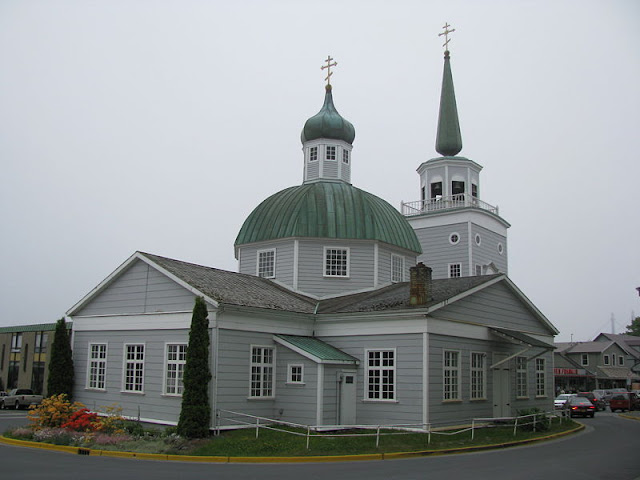Arriving in Sitka. It was Saturday, August 6, our last day on the Safari Endeavor. The crew weighed anchor about 5:45 am and we sailed towards Sitka. It was not long before we started seeing homes on the shore. I was genuinely surprised at how far homes extended along the waterfront as we approached the dock We sailed into the harbor and were tied to the dock by about 7 am.
 |
Watching the docking process from inside the lounge to avoid the steady rain.
|
We left our luggage outside our room when we went to breakfast. When we returned the bags were already gone, the beds were stripped, and most of the towels were gone from the bathroom. We finished throwing together the last of the things we were going to carry for the day and then made our way down the gangplank to the waiting shuttle bus. The crew was on the deck above to wave and send us off. It was genuinely sad to leave.
I had been looking forward to seeing Sitka. It is considered one of the more beautiful cities in
Alaska. It also has lots of history, having been the capital of Russian
Alaska and the site of the transfer of Alaska from Russia to the United
States.
I had already stumbled
upon the strange fact that Sitka, despite having a population of only a
little over 8,000, is the largest incorporated city by area in the U.S.
It has a total area of 4,811 square miles, almost four times the area
of Rhode Island! Our lead expedition guide on the ship, who lives in
Sitka, had explained to us that Sitka chose to incorporate large areas
at least in part to ensure the population density stays very low. It is
a low population density that enables hunting within the city and other
such things under Alaska state law.
Harrigan Centenneal Center. The shuttle bus made the five minute drive to the Harrigan Centenneal Center, Sitka's convention and visitor's center. Built during Alaska’s Centennial celebration in 1967, it had recently been remodeled and was a very nice facility. UnCruise had a hospitality room there where we found our luggage.
I was especially impressed by the canoe outside which had been hand carved from a single tree.
We couldn't check into our hotel until the middle of the afternoon, so we had time to do some exploring. Unfortunately it was steadily raining and the low cloud bank
totally obscured the nearby mountains let alone its most famous mountain, Mount Edgecumbe which is across
the harbor. The lousy weather plus the Frog's injured knee meant we would need to adopt an abbreviated sightseeing
schedule for the day. With that in mind, we bought a shuttle bus ticket that would take us to two popular tourist sites in Sitka: Fortress of the Bear and the Alaska Raptor Center.
Fortress of the Bear. Fortress of the Bear is a non-profit sanctuary for rescued bears on the site of an abandoned pulp mill. .Alaska state law does not allow captured bears to be returned to the wild. If a mother bear was killed, her orphaned cubs were euthanized. A Sitka outdoors-man wanted to save the orphaned bears, hence he founded Fortress of the Bears. It is not a zoo, but they allow visitors since the entrance fees are their primary source of income for operational expenses
Coastal Brown Bears. There are two very large bear enclosures that had been water clarifying tanks in the former pulp mill. These have 14 and 17 foot vertical high concrete walls. Open to the air and filled with dirt, trees, stumps, and flowing water, it is a habitat not unlike the surrounding forest. These house the brown bears currently living there.
Coastal brown bears are native to the Alexander Archipelago. Sometimes called Sitka brown bears or ABC Islands bears, coastal brown bears are a blend of polar bear and grizzly bear. They are typically larger than the grizzly bears found in the interior of Alaska. Even though called brown bears, their fur can be brown, black, or blonde.
A recent renovation of the viewing platforms made watching and photographing the bears from above quite easy. The bears seemed to really enjoy playing in the large ponds. The ponds are apparently much larger than normal due to all of the recent rain in Sitka.
 |
A teddy bear with very big claws.
|
Black bears. There were also three black bears. They were in an adjacent enclosure behind a chain length fence.

At least one of the black bears was hanging out in the trees.
We were not there long, but it was interesting to see these animals at close range.
The Fortress of the Bear website has a complete background for each of the eight bears. All of these bears will live out their lives here. Fortress of the Bear is currently at capacity with their existing facility, but they work to relocate bears to other sites in the country as needed. Their website indicates they have relocated bears to three sites: the Bronx Zoo, the Montana Grizzly Encounter and to the International Exotic Animal Sanctuary in Boyd, Texas. Small world!
Although now apparently working successfully with the Alaska Department of Fish and Game, various state agencies were initially opposed to a rescue facility such as Fortress of the Bear. According to our bus driver, the founders were required to prove they could care for and raise animals, so they srt up a facility for farm animals (cows, sheep, and chickens, I think). When the state agencies finally granted permission to keep bears, the owners got rid of the farm animals. That was to the dismay of the local school children. The children's' attitude was "Please keep the cows and sheep. We have seen bears many times before, but we have never seen farm animals."
Alaska Raptor Center. The shuttle then picked us up and drove back towards downtown, dropping us off at the Alaska Raptor Center.
The Alaska Raptor Center is a fairly large center on 17 acres that provides medical treatment to injured birds. In a typical year they treat over 200 birds. Unfortunately this was not a typical year. They had stopped taking in injured birds earlier in the year due to the avian flu.
Flight Training Center. During the tour, we were able to see the rather large, enclosed area for rehabilitating birds known as the flight training center. There was an area only for eagles and an area for other birds. Having not taken in new birds recently, there were only three eagles in the flight center, but it was still interesting to see. I could now better appreciate some of the features I had only read about on the website of the Blackland Prairie Raptor Center. Blackland Prairie Raptor Center is a facility in the DFW area where injured raptors often go from our area.
Although it made taking pictures nearly impossible, I was particularly impressed with how the viewing area for the flight center was constructed. It is darkened behind one way glass so the birds cannot see or hear the people. They are very anxious that the birds not become accustomed to being around people so they can be successfully released back into the wild.
Weathering Yard. There were also multiple outside cages known as a "weathering yard" Here the birds can be safely exposed to sunlight, rain and other elements during the day. The center feels this exposure is critical to the birds' physical and mental health. The birds are then returned to their individual mew at night. I believe all of these bird are among the 24 Raptors-in-Residence that are permanent residents of the Center.
 |
A different type of enclosure in the weathering yard for a Northern Saw-whet owl.
|
We did not spend a lot of time here, but it was interesting to see. Russia's national dish for lunch. It was noon by the time the shuttle bus dropped us back at the Harrigan Centennial Center, so we asked the person in the hospitality room for a recommendation for something simple and close by for lunch. She recommended Pel'Meni, which was a restaurant a couple of blocks away on Lincoln Street, the center of all of the action in downtown Sitka. We had no idea what type of restaurant it was, but off we went.
As we learned later, pelmeni is considered the national dish of Russia, certainly something appropriate in Sitka. They are pastry dumplings filled with minced meat and wrapped in a thin, pasta-like dough.
This was a very small and very simple hole in the wall restaurant. They offered only two types of pelmeni, beef or potato. Having no idea what they were, we ordered one of each and shared. We also had to choose a topping. To keep it simple, we went with butter.
The guy behind the counter stirred the dumplings in boiling water, then removed them with a strainer and plopped them onto a styrofoam serving container. Only much later did I find out he forgot to give us our sour cream and slice of rye bread. Oh well. I personally thought they were kind of plain, but they might have seemed different if they had been consumed in what one place on the web claims is a more traditional Russian manner, i.e. with a shot of vodka between each dumpling.
I was surprised to see later how almost everyone on all of the various review sites raved about this place. I especially liked this review by someone on tripadvisor. She really liked it, giving it 10 stars out of a possible 5. However, her comments, reproduced in part below, captured much of our experience as well:
If Anthony Bourdain was still alive, he would declare this the best
restaurant in all of Sitka, Alaska. This place ticks off every check on
the checklist of magical hole-in-the-wall eateries:
Hard to find - check!
Disinterested waitstaff - check!
Tiny - check!
Decor that looks like it was leftover from a 5 year old's birthday party - check!
Only 2 items on the whole menu - check!
Fresh Russian bread - check!
Long wait to be served - check!
Authentic Russian street food - check!
Inexpensive - check!
Delicious - check!
If
you manage to find this place tucked away beside a much larger and
busier tourist attraction, you will be rewarded with an amazing meal.
When you walk in, the sole guy standing behind the counter looks up from
stirring his crock pots and asks you "Beef or potato?"
Then you wait until he says the dumplings are cooked. Then he serves them in a styrofoam container
Having now experienced pelmeni, we went back to the Harrigan Centennial Center to hang out until we could check into our hotel.
Given all of our luggage and the Frog's increasingly sore knee, I tried to call a cab. None of the cab companies wanted our business since it was too short of a run. We therefore set off walking with part of the luggage. I would come back for the rest. As it turned out, it was a very short walk, but only after we discovered you cannot enter the Sitka Hotel from Lincoln Street even though Lincoln Street is their address. The only entrance is through the back. Go figure.
We finally got settled in our room with all of our belongings. I had planned to visit Baranoff Castle State Historic Site, which is immediately adjacent to the hotel. It is the location of the transfer of Alaska from Russia to the US. It also has fantastic views of the area. However, it was still raining hard with little visibility due to the low clouds, so I crossed that off of our list.
The other very close by attraction of interest that was indoors was St. Michael's Russian Orthodox Cathedral.
We walked the short distance up Lincoln Street to the Cathedral to discover the doors were locked. Oh well. We saw the outside.
With the rain still coming down and the need to get to the airport very early the next morning we opted for dinner at the restaurant on the first floor of the hotel. Day 11 of our epic adventure was complete. One more day to go.

_Moment-superzoomed.jpg)
_Moment-superzoomed.jpg)
_Moment-superzoomed.jpg)
_Moment-superzoomed.jpg)
_Moment-superzoom.jpg)
_Moment-superzoomed.jpg)





























-zoomed.jpg)









-darkened.jpg)










